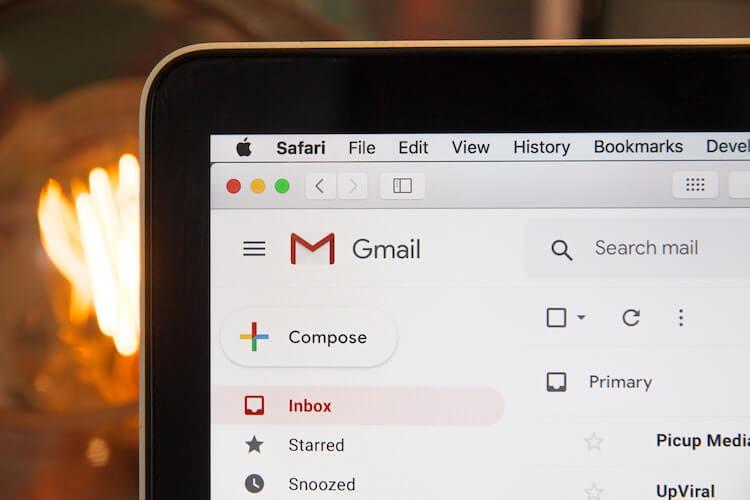By 2024, there are projected to be 4.48 billion email users worldwide.
The world around us has become increasingly more digital. It’s no surprise that email has become an integral part of daily life.
So, what better place is there to interact with customers than their inboxes?
Email marketing is a highly effective strategy to implement for your business. For one, you’ll see a great return on investment. According to the DMA, for every $1 spent on email marketing, there is an ROI of about $42.
It can also be a great way to build loyalty and trust with clients. Emails can help provide customers with useful information, engaging content, and personalized messages catering to their specific needs.
Overall, when taking your business to market, a robust email marketing strategy is key.

A computer opened to Gmail.
Types of Emails
Drip Campaign
A drip marketing campaign is a type of email campaign where emails get sent on an automated, time-based schedule. It is structured like a path — members of the email list are guided through a pre-set series of messages.
For instance, drip email campaigns may be used when an individual first subscribes to your service. Directly after, they will receive an automated “Welcome” email from your business. Then, after exactly three days, they might receive a message about the products or services you offer.
Some other types of drip campaigns are:
-
Regular Email Newsletters: sending emails on a regular period (weekly, monthly, etc.) providing updates or information about a topic
-
Client Onboarding Drips: a series of messages sent following a close with important resources
-
Re-Engagement Drips: a series of emails intended to boost engagement after an initial interaction
These automated emails can be a super easy way to generate new leads and drive sales.

A phone opened to its inbox in front of a white background and plant.
Lead Nurture Campaign
In a lead nurture campaign, the lead’s behavior determines when and what emails are sent. Unlike in drip campaigns, messages are triggered by specific actions, not time.
Examples of triggers are:
-
Clicking on a link
-
Registering for events or webinars
-
Viewing a certain product
-
Reading a blog
-
Downloading a pdf
Lead nurture email campaigns are great for improving user engagement.
For one, you can provide information right at the moment an individual shows interest. This is extremely valuable for guiding potential customers along the sales funnel.
Some types of lead nurture campaigns are:
-
Abandoned Cart Campaign
-
Post-purchase Campaign
-
Unsubscribe Campaign
Also, lead nurture campaigns often combine specific behavioral data to create targeted emails.
Keep in mind: as lead nurture campaigns cater to a highly personalized experience, they require more time and resources to implement.

A person types on their computer.
Implementing Email Marketing
1. Set Goals and Establish a Plan
Before you create your email marketing campaign, it is essential that you create a cohesive marketing plan. To do this, first identify key business goals. This is what you hope to achieve with email marketing.
Some examples of goals are:
-
Increasing sales
-
Building relationships
-
Strengthening loyalty of customers
-
Boosting website traffic
-
Generating new leads
-
Dispensing information
Once you pinpoint your email marketing goals, you can choose the most effective email marketing campaign.
Are you looking for an easy, short-term method for increasing sales and dispelling information? Then, go for a drip campaign!
If you want to build relationships, strengthen customer loyalty, and generate reliable long-term leads, go for a lead nurture campaign.

A person writes a list in their notebook.
2. Develop Your List
Before implementing your email marketing program, you may already have a few email addresses from loyal clients, stakeholders, and suppliers. This is great! If you have their permission, add them to your email list.
However, the real challenge comes when building subscriber lists. How do you get potential customers to sign up to receive emails?
The trick to this is simple: create painless opportunities with sign-up incentives.
First, this means that prospects should be provided with various openings to sign up for your email list. Take advantage of your many moments of interaction with potential customers to offer them a subscription.
These opportunities may be:
-
When a person first opens your website
-
After a purchase
-
As an individual browses your site
The simpler and more painless your sign-up form is, the better.
Second, each of these opportunities should offer an incentive to your prospects. Consider why a potential customer will subscribe to your email list.
Examples of incentives:
-
Promotional offers
-
Interesting exclusive content (blogs, social media posts, etc.)
-
Updates and announcements
And, perhaps the most important thing to remember when building email lists: always ask permission! Never add email addresses to your list without your contacts’ consent.
Interested in improving your website? Check out: 4 Ways to Launch A Fabulous Website Within Your Budget and Simple Ways to Update Your Website.

A man works at his computer.
3. Create Email Content
Email Marketing Services
When creating email content, using an email marketing service is crucial.
For one, with email marketing platforms, you can easily design your emails with drag-and-drop tools and email templates. Services also provide the email marketing automation needed to make your email series run efficiently.
And, last but not least, these platforms will help you:
-
Manage and segment your contact list
-
Measure your performance
-
Keep your emails out of spam
Here’s a list of Email Service Providers to check out:
-
Constant Contact
-
HubSpot
-
Sendinblue
-
ConvertKit
-
Drip
-
GetResponse
-
Mailchimp
-
AWeber
List Segmentation
One feature frequently found on email marketing services is list segmentation. List segmentation describes breaking up or “segmenting” the contacts on your list into different groups based upon their similarities.
Common ways to segment a list include by:
-
Demographic
-
Geography
-
Industry/Market
-
Buyer Personas
By segmenting your subscribers, you can better personalize content for their needs. For instance, a clothing company would not want to email individuals in warmer climates about winter coats. Geographic segmentation will prevent this waste of effort.
This ultimately will increase the response rate on each email you send.
There are two approaches to list segmentation:
- Using subscriber data to group into segments (done on the back-end)
- Allowing subscribers to sign up to separate email lists based upon preference

A tablet displays Email analytics.
4. Measure Results
Like any business campaign, evaluating the results of your email marketing strategy is crucial for future improvement. Once your email campaign is up and running, you can measure the success of your efforts.
Measure the results of your email campaign with the help of email marketing tools and website analytics services.
Refer to your email marketing service to better understand how people interact with your campaign. Along with offering design and automation features, email marketing tools gather data on your campaign.
In their reports, tools like MailChimp and Constant Contact can provide metrics on:
-
Website Traffic
-
Opens
-
Engagement Rate
-
Unsubscribe Rate
-
Click-Through Rate
-
Shares
Meanwhile, website analytics services, like Google Analytics, are essential to understanding what leads do after they click onto your website.
These tools help you track:
-
How long individuals spend on your site
-
The campaigns that brought them there
-
The pages they visit on your platform
This insight can help you evaluate what works in your campaign and what can be improved upon.
Conclusion
When taking your small business to market, implementing successful email marketing is key. These simple and cost-effective steps will be valuable in ensuring your email campaign is lasting and easy to manage. Not only will your business see significant ROI, you will also cultivate stronger relationships with old and new customers alike.
For more on affordable digital marketing strategies: The Most Affordable Marketing Strategies in 2021.

Leave a Reply
You must belogged in to post a comment.